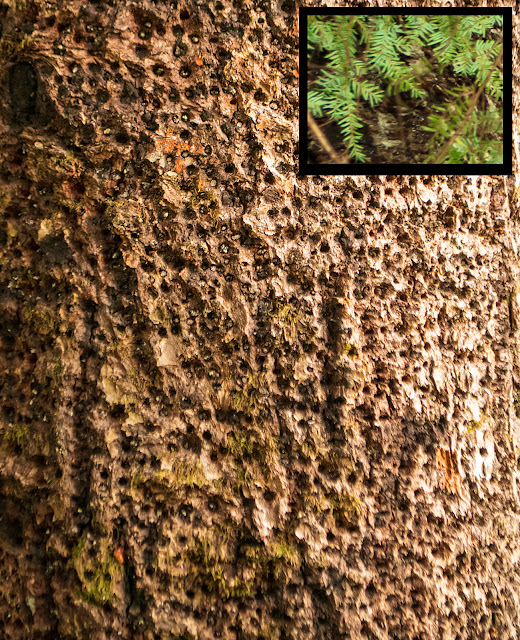And the second batch of scarred alder trunks shows the activity of birds, the red-breasted sapsuckers, I think.
 |
| Almost look like rows of puckered mouths. |
 |
| Two more alders with patches of healed holes, and a bit of moss. |
One strange thing we noticed, and couldn't guess at a reason for: on a large area of alders with many of the trunks pockmarked, the ring of holes would start at about 2 metres above ground, and go to at the most 3 metres, then stop. Further up, the trunks were undamaged. (We found one, later, where the holes started at about 1.5 metres.) Why?
 |
| This tree was swollen in the damaged area. Like my arm would be if someone filled it with holes. |
For comparison: sapsuckers also make their wells in hemlock. In this older photo, the holes went all around the tree, from the soil up as far as I could see.
 |
| Or was this a buggy tree, drilled by woodpeckers? |
Tomorrow: the trees have eyes.
~~~~~~~~~~~~~~~~~~~~~~~~~~~~~~~~~
Este segundo grupo de fotos muestra agujeros hechos por los pájaros chupasavias. (Eso creo.) Los chupasalvias hacen pocitos en la corteza y beben la savia que brota de esos pozos. Organizan sus pozos más o menos en lineas rectas, sea horizontal o verticalmente. Y dan la vuelta completa al tronco, haciendo agujeros alrededor.
Fotos #1 y 2: Troncos de alisos con pozos de savia, ya curados. Casi parecen bocas con los labios fruncidos.
Algo muy extraño, y que no pudimos imaginar cual fuera la razón: en un gran tramo de estos alisos, con muchos árboles minados por los pájaros, la zona de pocitos empezaba en casi todos los árboles a aproximadamente 2 metros arriba del suelo, y se extendía, a lo máximo, a los 3 metros. Más para arriba, los troncos seguían sin daño. (Más tarde, vimos un árbol, uno solo, donde los pocitos empezaban a 1,5 metros.)
¿Porqué sería?
En otros sitios, he sacado fotos de árboles completamente cubiertos de pocitos, desde el suelo hasta la corona del árbol. ¿Qué hay de diferente en este sitio?
Foto #3: Este pobre aliso se ve hinchado en la región afectada.
Para hacer una comparación: los chupasavias también usan los abetos. Aquí hay una foto (#4) de un abeto con miles de pocitos que empezaban desde el suelo y seguían hacia arriba hasta donde yo ya no podía ver.
Mañana: los abetos tienen ojos.

No comments:
Post a Comment
I'm having to moderate all comments because Blogger seems to have a problem notifying me. Sorry about that. I will review them several times daily, though, until this issue is fixed.
Also, I have word verification on, because I found out that not only do I get spam without it, but it gets passed on to anyone commenting in that thread. Not cool!